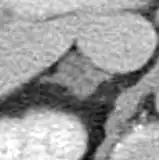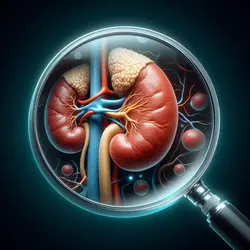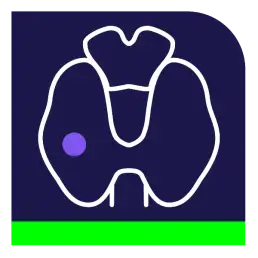Adrenal Washout Calculator & Report Generator for CT
References:
- Nandra G, Duxbury O, Patel P, Patel JH, Patel N, Vlahos I. Technical and Interpretive Pitfalls in Adrenal Imaging. Radiographics. 2020;40(4):1041-1060. doi:10.1148/rg.2020190080
- Ozturk E, Onur Sildiroglu H, Kantarci M, Doganay S, Güven F, Bozkurt M, Sonmez G, Cinar Basekim C. Computed tomography findings in diseases of the adrenal gland. Wien Klin Wochenschr. 2009;121(11-12):372-81. doi: 10.1007/s00508-009-1190-y. PMID: 19626294.
Related Calculators:

More about the Adrenal Washout Calculator
The adrenal washout calculator is a valuable diagnostic tool used in computed tomography (CT) to analyze the dynamic enhancement behavior of adrenal nodules. This technique assesses how rapidly contrast material is retained or cleared from an adrenal lesion over time. By quantifying these changes, the adrenal washout calculator helps radiologists distinguish between benign and potentially malignant adrenal masses using objective attenuation measurements. Its use has become an integral part of the non-invasive workup of adrenal nodules, guiding clinicians in determining the most appropriate next steps—whether that involves conservative monitoring or further evaluation.
What Are Adrenal Nodules?
Adrenal nodules, often referred to as adrenal incidentalomas, are adrenal gland masses discovered unexpectedly during imaging studies performed for unrelated reasons. These findings are common, with prevalence estimates ranging from 2% to 7% in the general population, and even higher in older adults. Most adrenal nodules are benign and non-functioning, but some may secrete hormones or represent malignant disease. This broad differential diagnosis underscores the importance of accurate, non-invasive characterization of these lesions.
The differential diagnosis for adrenal nodules includes a range of possibilities, such as:
- Adrenal Adenomas: These benign cortical tumors are often lipid-rich and show rapid contrast washout, especially when small and homogeneous.
- Adrenal Carcinomas: Aggressive and rare, these malignancies often exhibit irregular margins, heterogeneous enhancement, and slower washout kinetics.
- Metastases: The adrenal glands are a common site for metastatic disease, particularly from lung, breast, kidney, and melanoma primaries. These lesions typically show low washout percentages.
- Pheochromocytomas: Catecholamine-secreting tumors from the adrenal medulla, which can mimic other lesions both clinically and radiologically.
- Other Lesions: These include myelolipomas, cysts, hematomas, and rare infections or infiltrative processes.
Understanding the Adrenal Washout Calculator
The adrenal washout calculator operates by comparing Hounsfield Unit (HU) measurements taken at three key CT scan phases:
- Pre-contrast (unenhanced) phase: Establishes the baseline attenuation of the adrenal lesion.
- Portal venous phase (typically at 60–70 seconds): Captures peak enhancement after contrast injection, highlighting lesion vascularity.
- Delayed phase (10–15 minutes post-contrast): Reflects how much contrast the lesion retains over time, which varies depending on its composition and vascular permeability.
The adrenal washout calculator uses these values to compute two essential parameters:
- Absolute Washout Percentage (AWP): Quantifies how much contrast the lesion has lost compared to its peak, normalized against the unenhanced value.
- Relative Washout Percentage (RWP): Assesses contrast clearance relative only to the peak enhancement, without referencing the unenhanced baseline.
Interpreting Washout Values
Specific threshold values have been established to help categorize adrenal lesions based on their washout behavior:
- AWP ≥ 60% or RWP ≥ 40%: Suggestive of benign adenoma, especially when other imaging features (e.g., smooth margins, small size) are also present.
- AWP < 60% and RWP < 40%: May indicate non-adenomatous lesions such as metastasis, pheochromocytoma, or carcinoma, prompting further investigation.
While these thresholds provide guidance, they are not absolute and must always be interpreted in the context of patient history, other imaging features, and laboratory findings.
Clinical Applications of Adrenal Washout Analysis
The adrenal washout calculator provides a means of evaluating adrenal nodules with greater precision and consistency. This is particularly useful when unenhanced CT findings are inconclusive, such as when a nodule has an intermediate attenuation (10–30 HU) that does not clearly indicate lipid-rich adenoma. In these cases, assessing washout kinetics can help clarify whether the lesion is likely benign or warrants closer follow-up.
In clinical practice, the adrenal washout calculator is commonly used to:
- Confirm a diagnosis of adrenal adenoma without needing additional imaging modalities.
- Distinguish metastases in patients with known malignancies.
- Reduce the number of unnecessary adrenal biopsies.
- Support decisions about endocrine testing when functional lesions are suspected.
Imaging Protocol and Technical Considerations
- Consistent Timing of Delayed Images: Typically acquired 10–15 minutes post-contrast; too early or late timing can lead to misleading calculations.
- ROI Placement: Regions of interest should be drawn over the most solid and homogeneous portion of the lesion, avoiding necrotic, cystic, or hemorrhagic components that could skew HU readings.
- Image Quality and Calibration: Consistency across scanners and protocols is important to ensure reproducibility. Beam hardening artifacts and motion blur should be minimized.
Challenges and Limitations
- Small Lesion Size: Lesions smaller than 1 cm may be difficult to evaluate accurately due to partial volume effects and measurement variability.
- Variable Contrast Dosing: Inconsistent contrast injection protocols can affect enhancement patterns.
- Renal Function: Delayed contrast clearance in patients with impaired kidney function may alter expected washout behavior.
Complementary Imaging Approaches
In cases where adrenal washout analysis yields indeterminate or borderline results, other imaging techniques may be considered. Magnetic resonance imaging (MRI), particularly using chemical shift imaging, can help detect intracellular lipid and differentiate adenomas from non-adenomas. Functional imaging, such as FDG-PET or MIBG scans, may be employed when pheochromocytoma, metastasis, or adrenal carcinoma is suspected based on imaging or clinical data.
Conclusion
The adrenal washout calculator enhances the radiologic assessment of adrenal nodules by offering a structured, reproducible, and evidence-based approach to interpreting contrast kinetics. While no diagnostic tool is without limitations, the calculator has proven to be a valuable addition to the radiologist’s toolkit, supporting accurate differentiation of adrenal lesions in a wide variety of clinical contexts. Its integration into routine imaging workflows reflects the growing emphasis on precision medicine and the increasing reliance on quantitative imaging biomarkers in everyday clinical care.
Frequently Asked Questions (FAQ)
- What does the adrenal washout calculator measure?
It calculates how quickly contrast material leaves an adrenal lesion over time on CT. This helps distinguish benign adenomas, which wash out contrast rapidly, from malignant or metastatic lesions that retain contrast longer. - What are absolute and relative washout percentages?
Absolute washout (AWP) compares delayed and unenhanced values, while relative washout (RWP) compares delayed and enhanced values. In general, AWP ≥ 60% or RWP ≥ 40% suggests a benign adenoma. - When is the adrenal washout calculator most useful?
It’s especially valuable when a lesion shows intermediate attenuation (10–30 HU) on unenhanced CT, where it’s not clearly lipid-rich. Washout analysis can help determine whether it’s likely benign or requires further evaluation. - Can adrenal washout analysis replace MRI or biopsy?
Not always. While many adenomas can be confidently diagnosed on washout CT, indeterminate or atypical lesions may still need MRI (especially chemical shift imaging) or, in rare cases, biopsy for confirmation. - What imaging protocol should be followed for accurate washout measurement?
Three CT phases are required: unenhanced, portal venous (around 60–70 seconds after contrast), and delayed (10–15 minutes later). Consistent timing and accurate ROI placement are essential for reliable results. - Can small adrenal lesions be analyzed with this calculator?
Small lesions under 1 cm are challenging due to partial volume effects and measurement variability. The calculator is more reliable for nodules large enough for accurate ROI selection. - Do all adenomas show high washout?
No. Lipid-poor adenomas may not meet standard washout thresholds and can appear indeterminate. These cases often benefit from chemical shift MRI for further assessment. - What are common pitfalls in adrenal washout CT?
Errors may occur from inconsistent timing, incorrect ROI placement, motion artifacts, or variable contrast dosing. Proper technique and awareness of these factors help ensure accuracy. - How does adrenal washout help in oncology patients?
In patients with known cancer, adrenal washout helps differentiate metastases from benign adenomas, reducing unnecessary biopsies and ensuring appropriate follow-up. - Is the adrenal washout calculator sufficient on its own?
It’s a key part of adrenal lesion characterization but should always be interpreted alongside patient history, hormonal evaluation, and other imaging studies for a complete diagnostic picture.





forever grateful in your for your contributions!